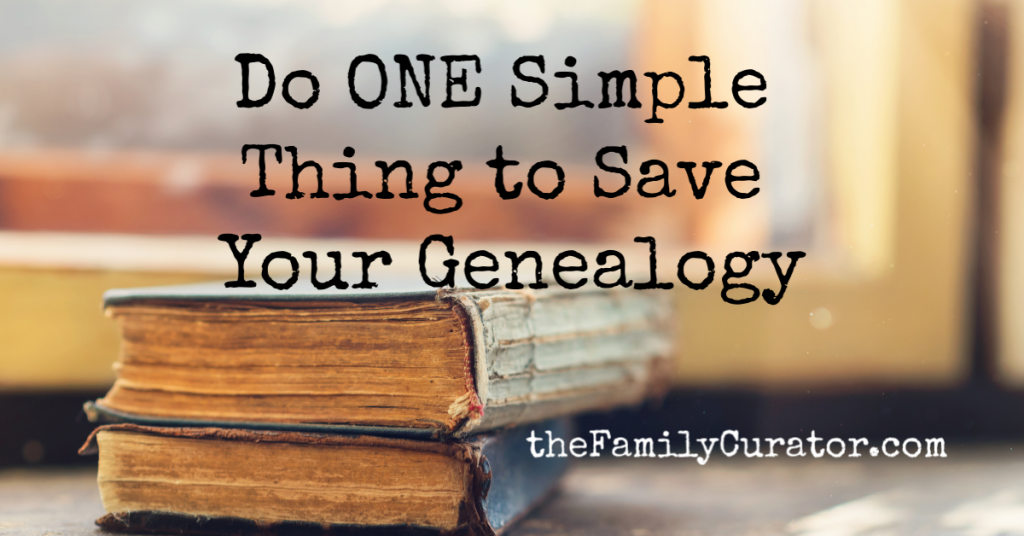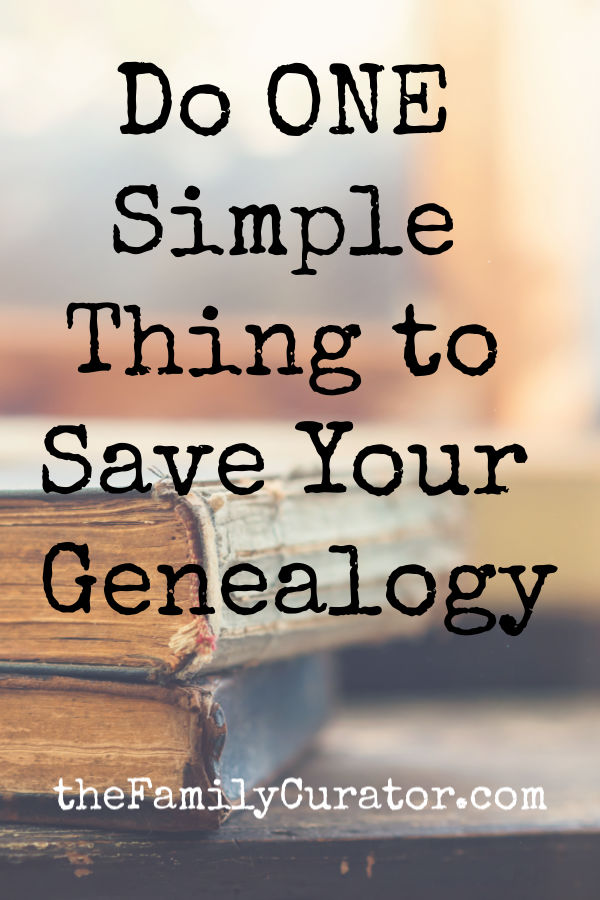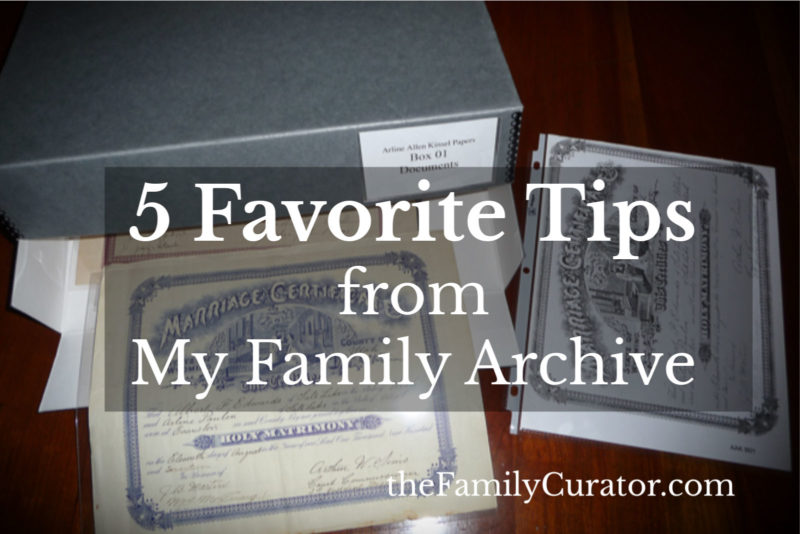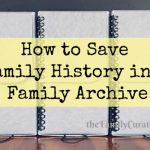 Genealogists aren’t just interested in the past. We want to save our genealogy. Most of us care about preserving our legacy for the future, whether or not another generation is ready to continue our family history research.
Genealogists aren’t just interested in the past. We want to save our genealogy. Most of us care about preserving our legacy for the future, whether or not another generation is ready to continue our family history research.
We may have an estate plan that includes our genealogy work. We may plan to donate family heirlooms and documents to a local archive or upload digital images to an online site for access by future researchers. But, whatever we would like to be the future for our genealogy can’t happen when our research notes, digital files, heirlooms, and photos are scattered throughout our homes and computer storage devices.
Family History Everywhere
Stop and look around your home. Is heirloom furniture part of daily life? Is genealogy research everywhere? Are family photos and papers stashed in various unused closets or cupboards?
It’s a good thing to share family photos and heirlooms in our homes. It’s not so good when treasures become over-familiar and we forget the story.
Research is hard to find when it’s scattered between filing cabinets, bookcases, closets, old and new computers and hard drives, and on various cloud services.
Daily life is complicated and messy. Stuff gets lost. Don’t let your genealogy get lost too.
ONE Place to Save Genealogy
No one really wants to live in a Dewey-Decimal ordered archive, but it’s a good idea to maintain enough order that someone else can locate and understand your collected family treasures and your hard-earned genealogy research results.
Think of your house as an inherited family archive and do ONE thing that will help save your genealogy legacy. Gather together your genealogy in ONE place within your home, as much as possible.
- Write the history of your heirloom for an heirloom notebook with photos and provenance for special artifacts. Keep that notebook with your other genealogy papers.
- Organize family recipes in a single album or firebox. Store the book in the kitchen or with your genealogy.
- Consolidate digital files in easy access up-to-date storage devices. Dispose of old media.
- Collect family research binders or folders on a shelf or file cabinet.
- Arrange photo albums on one or two shelves.
- Gather together loose photos, old negatives, and film scattered in boxes, drawers throughout the house. Store them in one place where items are easy to find.
And, when you’ve collected every family history document, photo, and artifact walk around your home and list what you have saved, and where it is located. Keep your ancestors together so they don’t get lost!
Be a Genealogy Gatherer
All this hunting and gathering around your home doesn’t cost anything except your time. Don’t worry now about moving genealogy keepsakes and research to preservation quality acid-free boxes. Save that task for later. Instead, focus on collecting things in one place.
Consolidating your genealogy may sound like an impossible task if you’ve been researching your family for decades. Your research notes may have spread out over the years. But, you may also rediscover missing papers and lost artifacts in your quest to round-up wayward genealogy work.
Sometimes family archivists focus on sorting, organizing, and digitizing individual boxes of old documents or photographs and lose sight of the big picture. Maintain order with the entire archive, not just a few boxes. Do this ONE thing to save your genealogy. Future genealogists will thank you.
If you like this article, please SHARE!







I’m looking for someone who can help me do the work needed to consolidate my caches of years of genealogy work.
I suggest finding a local member of the Association of Professional Genealogists who can help you with your project. The website address is Association of Professional Genealogists. Look under the “Find a Professional” sidebar for your location. Best wishes with your project.
A very important first step, however, there are also very important next steps. You conclude your article with “Share”.
People should share among family – get the photos, stories, etc. out of the computer, binders, etc. Living in California, especially the last 2 years brings home the fact that you need more than just scanning your photos to have them “saved” in the computer. #1: You need backups for the computer information. #2: Home fire safes are not safe in a wildfire – the contents become ash. #3: I hear “experts” over and over saying have a “GO” bag for each member of the family! What I have yet to hear one say is what happens if no one is home! Is someone home 24/7? Rarely. #4: You should have archival storage or LOCKSS. I have done classes on Disaster, Dead, etc. and it is getting very complicated with social media, new laws, etc. The easiest way to preserve your photos, family history is to SHARE. Spread it out! Get some out of the immediate area!
Good reminders, Linda! It’s never enough to have copies on our computer hard drive, or in our homes. We need backups to the Cloud or stored on external storage devices off-site.
Sound advice. I might add that people should also be encouraged to Write and Publish their family history. I have found that the process of putting it in print forces us to determine what is important and needs to be passed on/known by everyone in the family. I attempt to include as much BMD (birth, marriage, death) copies as possible. I have found that I have boxes and boxes filled with information but not all worthy of being in The Book. Same with photos, which to include forces us to down select to just the ones that portray our story the “best”. I have given copies to all immediate family members. By widely distributing it, it helps insure survival should a catastrophe such as storm or flood happen. For one, I had a relative present a copy to the local historical society, in hopes it may be saved and available to future generations long after I’m gone.
You are so correct, Pete. Writing our family history is essential to preserving it! I love seeing written family histories on the shelves of local libraries and societies. More copies are good for preservation. Thanks for the reminder.
Great advice Denise. I find the biggest hurdle for people to get over is the first one – getting started ie. digging boxes out of the attic or basement. If you have time to read my blog on handling lots of photos, I’d appreciate your comments.
Regards
Adair
https://www.heir-share.com/blog/36/All+Those+Photographs
You’ve hit the nail on the head, Adair!
What a great article. This one I printed out. It is very timely and spot on.
Susan